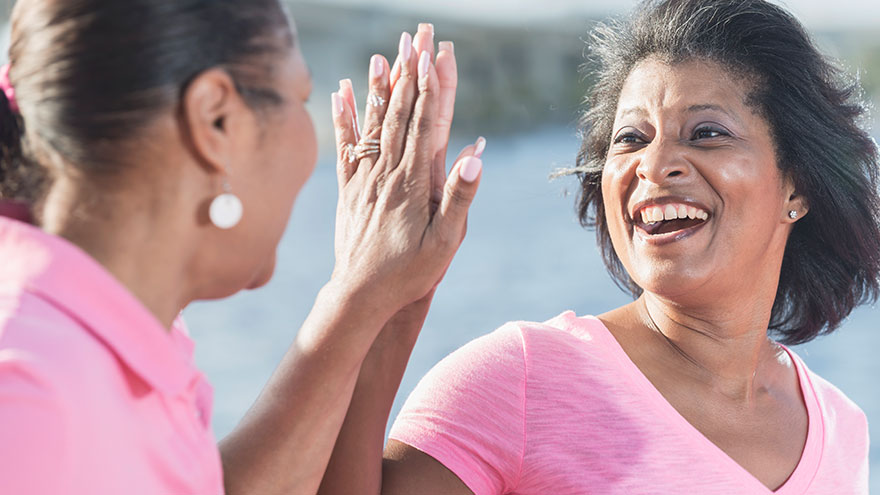Buscar
-
¡Damas! Hágase un examen de detección de cáncer de mama
Early detection is a significant piece of the breast cancer puzzle. Susan Cox, Renown Health Senior Director of Cancer Operations, discusses what you need to watch for and how the latest technology can help detect potential cancer sooner. When should women start getting breast exams? It depends on risk factors: Average-risk women: Most medical organizations recommend the first mammogram between 40 and 44. Higher-risk women: Dependent on their high risk, which will dictate when they start screening, but generally around the age of 30 and not before 25 years old.
-
¿Las mamografías duelen? 4 Mitos desacreditados
Mammograms are an effective means for early detection of breast cancer. Still, many women shy away from them for fear of pain or discomfort. Let us debunk a few mammogram myths that will remove your worries and encourage proactive breast health. Reviewed by Dr. Colleen O'Kelly-Priddy, MD, FACS, breast surgical oncologist at Renown Women's Health. Myth 1: Mammograms Are Painful Reality: Although some women experience discomfort during a mammogram, most say it is not painful. Breast compression, which is important to get a clear image, can cause a sensation of pressure, but this lasts for a few seconds. Let your technician know how much pressure you can handle so you're not uncomfortable. Myth 2: Discomfort Persists Long After the Procedure Reality: The sensation of pressure developed through the compression process diminishes quickly after the procedure. Most women go about their day afterward without experiencing any residual pain.
-
7 Síntomas del cáncer de mama en mujeres jóvenes
Cancer can develop at any age, and that’s why the experts at Renown are ready to help you stay ahead of breast cancer, especially if you're in your 20s or 30s. We're talking about early detection, signs to be aware of, and why being proactive is a big deal. Studies show there has been an increase in breast cancer in younger women. Although breast cancer is rare in women under 40, when it occurs, it tends to be aggressive. The tricky part? Many young women don't think it can happen to them, so they don't check for the signs as often as they should. Reviewed by Dr. Colleen O'Kelly-Priddy, MD, FACS, breast surgical oncologist at Renown Women's Health. Early Signs and Symptoms New or Different Lump in the Breast: A lump is probably the most well-known symptom. Breast cancer is usually painless and firm, but it can also be soft. If you find a new lump, don't panic, but don't ignore it either. Changes in Breast Size or Shape: Have you noticed that one breast looks a little different? Whether it's swelling, shrinking, bulging, dimpling, or seems off, it's worth mentioning to your doctor. Skin Changes: If the skin on your breast starts to thicken or turn red, it's time to pay attention. If your skin starts looking like an orange peel (thickened, with prominent pores), that warrants evaluation. Nipple Discharge: Spontaneous drainage coming from your nipple that isn't breast milk—especially if it's clear or bloody—should be checked out. Nipple Changes: If your nipple starts to invert, flatten, or look different, call your doctor. Breast Pain: Continuous pain in your breast or nipple that isn't linked to your menstrual cycle is another symptom to note. However, breast pain is very common and is only rarely a sign of cancer, so don’t panic. Swelling or Lumps in the Armpit: When it spreads, breast cancer usually first goes to the lymph nodes in the armpit, so swelling or lumps under your arm should be on your radar.
-
Por qué son tan importantes las inmunizaciones infantiles
Immunizations save thousands of lives each year by preventing serious illnesses, hospitalizations, and deaths. They also protect those who can't be vaccinated, like young children and the elderly, through herd immunity. Renown Pediatrician Dr. Kristin Wilson highlights the crucial role of vaccines. Immunizations Your Child Needs (and when) Birth to 6 Months Hepatitis B: Shortly after birth, first vaccine dose Diphtheria, Tetanus, and Pertussis (DTaP), Polio, Haemophilus Influenza (HiB), Pneumonia, Hepatitis B and Rotavirus: Ages 2, 4 and 6 months, boosters and vaccines One Year to 18 Months MMR and Varicella (chickenpox) vaccine: Age 1, first vaccine dose Hepatitis A, HiB and Pneumonia: Age 1, booster DTaP: 15 months, fourth vaccine dose Hepatitis, second dose: 18 months Flu Vaccine: 6 months and older, annually* *In the year after receiving their first dose, an infant will need a booster one month later. Four Years Old MMRV, DTaP and Polio, final dose: Four years of age Pre-Teen and Beyond Tdap and Meningitis: Before starting middle school, children receive these vaccines. They are also old enough to start the HPV vaccine, an essential vaccine for all young adults to protect against cancer, genital warts and cervical dysplasia.
Read More About Why Childhood Immunizations Are So Important



